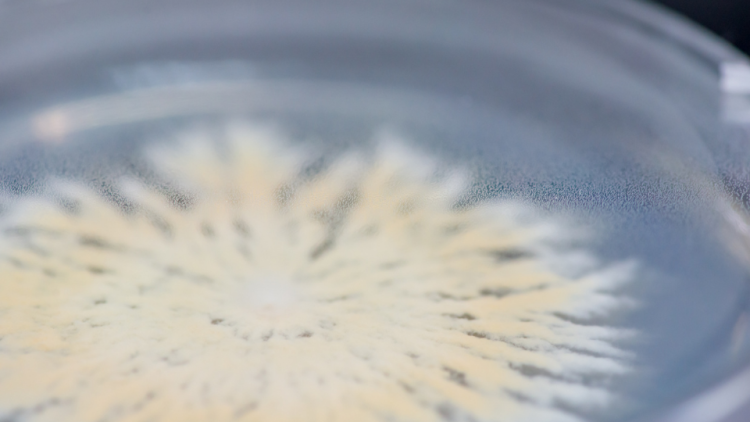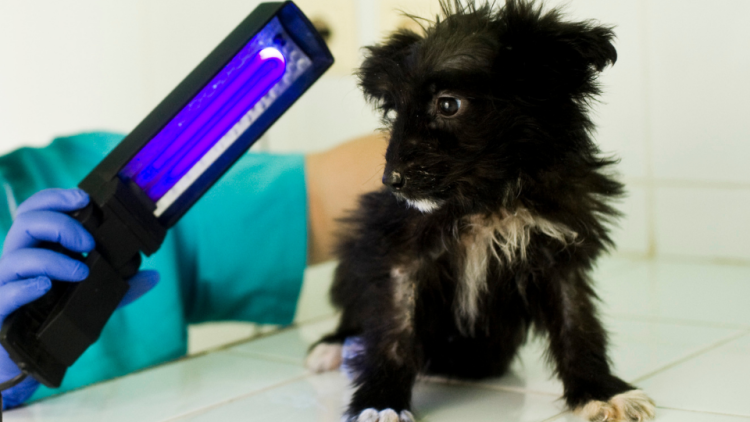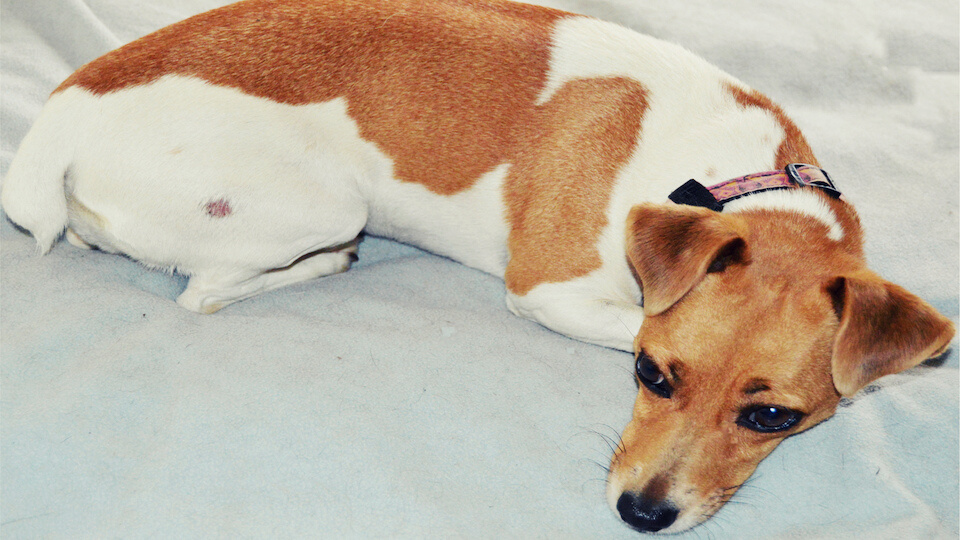We’ve previously discussed other parasites in dogs, including hookworms, tapeworms, and Giardia, but do ringworms fall into the same category? Despite the name, no, ringworm is not a parasite but instead is a common fungus in many animal species, including dogs.
In this article, we’ll discuss the difference between a fungal infection and bacterial infection, as well as the most common symptoms of ringworms in dogs. We’ll also cover how to treat ringworms in dogs, so you can prepare for a visit to the vet. Use the links below to jump ahead for answers to some of the most common canine ringworm questions.
Table of Contents:
- What is ringworm?
- What causes ringworm in dogs?
- How does ringworm spread?
- Are all dogs at risk of ringworm?
- Can ringworm spread from dog to cat?
- Can humans get ringworm from dogs?
- What are the symptoms of ringworm in dogs?
- How to diagnose ringworm in dogs
- How to treat ringworm in dogs
- How long does ringworm last in dogs?
- How to prevent ringworm in dogs
- Key Takeaways
Pro tip: By enrolling your dog in pet insurance, you could be reimbursed for up to 90% of vet costs, including illness caused by a fungal infection like ringworm.
What is ringworm?
Ringworm, also known as dermatophytes, is a fungal infection of the skin, nails, and hair. The name comes from the appearance of circular lesions caused by the fungus. There are several species of ringworm in dogs
- Microsporum canis (70% of cases)
- Microsporum gypseum (20% of cases)
- Trichophyton mentagrophytes (10% of cases)
What causes ringworm in dogs?
Ringworm fungi feed on the keratin present in the superficial layers of the skin, nails, and hair. In most cases, the infection only affects certain areas of the dog’s body, usually the ears, face, tail, and feet.
In dogs, these lesions typically appear as patches of hair loss. The lesions aren’t usually itchy, but they might become inflamed and form scabs. In some cases, the infection affects the nails making the claws brittle, broken, and rough.
How does ringworm spread?
There are a few ways dogs can get ringworm:
-
Dogs with weakened immune systems are at a higher risk for infection. Some dogs might have the disease without showing any symptoms. These dogs are called ‘asymptomatic carriers' and can spread the infection to other pets or people. Asymptomatic carriers are particularly problematic in places where a big number of animals are closer together, like kennels, pet shops, and animal shelters. The same counts for environments where there are poor management practices and poor nutrition.
-
Dogs often catch ringworm through direct contact with infected animals or people. The fungus can also be spread through contact with contaminated objects like dishes, bedding, combs, brushes, cages, and clippers. Furniture, carpets, rugs, or anywhere dog hair can collect might also harbor ringworm, which is why it’s important to meticulously clean any area that an infected pet has touched.
-
Some species of the fungus also live in the soil, so dogs can become infected after contacting dirt or feces. Ticks and other animals might also carry the fungus.
The incubation period between exposure to the fungus and the development of lesions usually ranges from seven to 14 days, although some cases might take up to three weeks before symptoms of infection develop.

Are all dogs at risk of ringworm?
Yes, although ringworm doesn’t infect every dog that’s been exposed. Several factors increase the likelihood and severity of infection:
- Age
Senior dogs and puppies have weaker immune systems that are less resistant to fungi.
- Behavior
Pups that have a bad habit of digging, hunting small animals like mice, or eating feces are more likely to come into contact with fungi spores.
- Medications and health conditions
Immunocompromising diseases and immunosuppressive medications decrease the dog’s ability to fight off germs.
- Disruptions to the normal protective barrier of the skin
Flea infestation and wounds can increase your dog’s susceptibility to ringworm infection.
- Breed
Yorkshire Terriers, Boston Terriers, and Jack Russels are more susceptible to ringworm infection.
Can ringworm spread from dog to cat?
Yes, ringworm infections can occur in most domesticated animal species including livestock, and ringworm in cats is very common. In fact, M. canis, the fungus responsible for the majority of ringworm cases in dogs, is also responsible for 98% of ringworm cases in felines. Many pet parents own both dogs and cats, which makes the risk of spreading a ringworm infection from one animal to another quite high.
Can humans get ringworm from dogs?
Yes, humans are susceptible to the same ringworm infection as dogs and cats. Anyone can contract the M. canis fungus, but older people, children, and those with weakened immune systems are more at risk.
In people, ringworm presents as a round, red rash that’s often itchy. If you notice a rash on your body after your pet has ringworm, be sure to get in touch with a medical professional.
What are the symptoms of ringworm in dogs?
Ringworm isn’t life-threatening but it’s highly contagious and requires the intervention of a vet in order to prevent it from spreading. Symptoms of ringworm often include the following:
- Patchy or circular areas of hair loss (alopecia) throughout the body
- Scabby and inflamed skin
- Crusting of the skin
- Darkened or red skin
- Dry, brittle hair
- Dandruff scales
- Ulcerated or reddened skin
- Rough and brittle claws
- Itchiness (pruritus)
In rare cases, dogs develop nodular dermatophytosis (kerion). The claw folds and nails can also be infected, resulting in brittle or deformed nails.
Inflamed skin, hair loss, and changes in coat appearance can be a sign of another condition such as hypothyroidism, Cushing’s disease, or a nutrient imbalance. These symptoms can also signal skin conditions like allergies, a different infection, or a parasite.
Be sure to contact your vet as soon as possible if you notice any of these clinical signs of ringworm.
How do you diagnose ringworm in dogs?
In order to determine whether your dog has ringworm, your veterinarian will perform a few tests and exams.

-
It all starts with the identification of the typical round lesions on the skin. This method isn’t very accurate and for that reason, additional tests are required in order to confirm the presence of ringworm fungi.
-
The Wood's lamp test involves the use of a special ultraviolet lamp to fluorescence the infected hairs. When the dog’s coat and skin are examined with this lamp, the M. canis will glow yellow-green. It should be noted though that not all cases of M. canis will glow, and neither M. gypseum nor T. mentagrophytes glow under a Wood's lamp. On the other hand, dead skin cells, skin ointments, and other materials can glow, giving a false-positive result. This means that Wood’s lamp test is not always reliable and should be used only for rapid screening.
-
A fungal culture of skin scrapings and infected hairs from the affected area is the most accurate method. The vet will place the collected sample on a culture medium where the fungi can grow. Because it takes time for the organism to grow, results might not be available for up to four weeks. However, preliminary results can be obtained within five days.
Pro Tip: While these diagnostic tests can contribute to a longer and happier life for your four-legged friend, they can be quite expensive. Luckily, comprehensive pet insurance coverage will reimburse up to 90%, depending on the policy you choose.
How to treat ringworm in dogs
The treatment will depend on several factors, including the severity of the case and the number of pets in your household. Ringworm in dogs is commonly treated with a combination of topical therapy and oral drugs. In addition, your vet will likely provide guidelines on how to eliminate environmental contamination in order to prevent the further spread of the infection.
Topical ringworm treatment
Your vet will probably prescribe a topical therapy, like an ointment, cream, or special medicated shampoo. They may also recommend clipping long-haired dog-breeds like Afghan Hounds and Border Collies, and shaving the hair from affected areas in order to accelerate healing. Topical therapy can take several weeks to several months to completely eliminate the ringworm infection.
Oral ringworm medications
Most commonly, topical therapy is used in combination with oral medications. Griseofulvin is the most commonly used antifungal drug, but there are also other options like terbinafine and itraconazole.
Treatment usually lasts for at least six weeks. Ringworm cultures should be taken from time to time after the treatment has started in order to determine if your dog is still infected. Two consecutive negative ringworm cultures are needed to confirm that your four-legged friend has been treated.
If you own more pets, try to confine the infected pet to one room. If this is not possible, all your pets will need to be treated for ringworm. Talk to your vet about the best course of treatment for your circumstances.
How long is ringworm contagious in dogs?
With aggressive treatment, dogs infected with ringworm remain contagious for about 21 days. If minimal measures are taken, or the vet’s recommendations are loosely followed, the infection may last longer.
When treated properly, most dogs will recover completely. However, the dog ringworm symptoms may recur if treatment is too weak, too short, or too ineffective due to another health complication. It’s best to continue treating your dog’s ringworm until your vet says otherwise.
How to prevent ringworm in dogs
Ringworm vaccines are available, but only in combination with treatment. These vaccines are rarely used due to the need for treatment regardless. The best way to prevent ringworm in dogs is to maintain good hygienic practices and a clean, sanitary environment.
If your dog has ringworm, you’ll need to fully decontaminate the home of spores, as well as any items that the infected pet has come into contact with, or you risk the spread and recurrence of infection. Try to keep the infected animal in a separate room that’s easy to clean.
How to kill ringworm at home:
- Use a mop and disinfectant to eliminate infected hairs.
- If there are carpets and rugs, vacuum them on a daily basis.
- Handle rugs and fabrics with medical-grade gloves and make sure all furniture is thoroughly cleaned.
- Use a diluted bleach solution (10 parts water:1 part bleach) to disinfect all surfaces, toys, and bedding.
If you suspect your dog has ringworm or you need more information, get in touch with your veterinarian.
Key Takeaways
- Ringworm is a fungus that affects a dog’s skin, hair, and nails. Dogs infected with ringworm suffer hair loss and red, crusty covering (often in round patches).
- Ringworm is highly contagious and can easily spread. Dogs can get infected through direct contact with other infected species or indirect contact with contaminated objects (dishes, bedding, toys, etc.).
- Puppies, seniors, and immuno-impaired dogs are at the highest risk of ringworm infection.
- Treatment can take several weeks but is effective in most cases.
- If you suspect your dog has ringworm, contact your vet.
